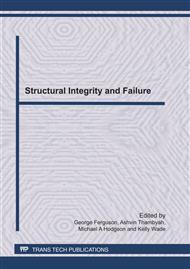p.35
p.39
p.43
p.47
p.51
p.55
p.59
p.65
p.69
An Impregnation Technique for Crack Identification Following Uniaxial Tension Tests
Abstract:
This paper is dedicated to an impregnation technique for crack identification of uniaxial tensile behaviour of concrete samples. A method for crack identification in concrete after uniaxial tension tests was adopted for the observation of differences between various experiments which were conducted with and without the elimination of secondary flexure. During the procedure an epoxy resin containing fluorescent dye was infused into concrete samples by vacuum to expose cracks and defects. After impregnation the samples were sawed from the prism and pictures taken under ultraviolet light.
Info:
Periodical:
Pages:
51-54
Citation:
Online since:
July 2011
Keywords:
Price:
Сopyright:
© 2011 Trans Tech Publications Ltd. All Rights Reserved
Share:
Citation:


